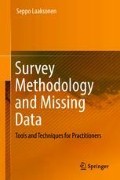Abstract
This chapter considers imputation methods for single variables. Naturally, it may be necessary to impute the values of several variables in each dataset and to carry out several imputations for each dataset. It is essential to understand the basics of Chap. 11, which presents the starting point for imputation methods. It is helpful to look at that chapter for the core terms, but an important question is also why one should, or should not, use imputation. Before answering this question, it is necessary to analyse the missingness and the reasons for it thoroughly. Then again, it is good to remember that the imputation methodology always depends on the case; thus, each variable should be separately imputed even though the principles of the method used can be similar. Successful imputation therefore is ‘tailored’ to the specific case, and the best results are obtained if the ‘imputation team’ has sound knowledge of the basis of the data and its quality.
Access this chapter
Tax calculation will be finalised at checkout
Purchases are for personal use only
References
Allison, B. D. (2005). Imputation of categorical variables with PROC MI. In SUGI 30 Proceedings. Retrieved February 2015, from http://www2.sas.com/proceedings/sugi30/113-30.pdf
Björnstad, J. (2007). Non-Bayesian multiple imputation. Journal of Official Statistics, 23, 433–452.
Carpenter, J., & Kenward, M. (2013). Multiple imputation and its application. Chichester, West Sussex: Wiley.
Chambers, R. L., Hoogland, J., Laaksonen, S., Mesa, D. M., Pannekoek, J., Piela, P., et al. (2001). The AUTIMP-Project: Evaluation of imputation software. Research Paper 0122. Statistics Netherlands, Voorburg.
Enders, C. K. (2010). Applied missing data analysis. New York: Guilford Press.
Laaksonen, S. (2000). Regression-based nearest neighbor hot decking. Computational Statistics, 15, 65–71.
Laaksonen, S. (2003). Alternative imputation techniques for complex metric variables. Journal of Applied Statistics, 30, 1009–1020.
Laaksonen, S. (2016a). Multiple imputation for a continuous variable. Journal of Mathematics and Statistical Science, 2016, 624–643. Science Signpost Publishing, Newark, DE.
Laaksonen, S. (2016b). A new framework for multiple imputation and applications to a binary variable. Model Assisted Statistics and Applications, 11, 191–201.
Laaksonen, S. & Piela, P. (2003). Integrated modelling approach to imputation. In Euredit Project Documents. Standard Methods, D512 StatFI. Retrieved October 2004, from http://www.cs.york.ac.uk/euredit/)
Laaksonen, S., Rässler, S., & Skinner, C. (2004). Documentation of pseudo code of imputation methods for the simulation study. In DACSEIS Project Research Papers under Workpackage 11.2 ‘Imputation and Nonresponse’. Retrieved March 2004, from www.dacseis.de/deliverables
Lago, L. P., & Clark, R. G. (2015). Imputation of household survey data using linear mixed models. Australian and New Zealand Journal of Statistics, 57, 169–187. https://doi.org/10.1111/anzs.12108.
Muñoz, J. F., & Rueda, M. M. (2009). New imputation methods for missing data using quantiles. Journal of Computational and Applied Mathematics, 232, 305–317.
Rubin, D. (1987). Multiple imputation for nonresponse in surveys. New York: Wiley.
Rubin, D. (1996). Multiple imputation after 18+ years. Journal of the American Statistical Association, 91, 473–489.
Rubin, D. (2004). Multiple imputation for nonresponse in surveys. Hoboken, NJ: Wiley-Interscience.
SAS/STAT 9.3 (2011). Help and Documentation, Users’ Guide for the MI Procedure. Details. SAS Institute Inc., Cary, NC.
Wagstaff, H. (2003). Appendix B: data sets and perturbations. In Euredit project, vol. 2. Retrieved October 2004, from http://www.cs.york.ac.uk/euredit/)
Author information
Authors and Affiliations
Rights and permissions
Copyright information
© 2018 Springer International Publishing AG, part of Springer Nature
About this chapter
Cite this chapter
Laaksonen, S. (2018). Imputation Methods for Single Variables. In: Survey Methodology and Missing Data. Springer, Cham. https://doi.org/10.1007/978-3-319-79011-4_12
Download citation
DOI: https://doi.org/10.1007/978-3-319-79011-4_12
Published:
Publisher Name: Springer, Cham
Print ISBN: 978-3-319-79010-7
Online ISBN: 978-3-319-79011-4
eBook Packages: Mathematics and StatisticsMathematics and Statistics (R0)

